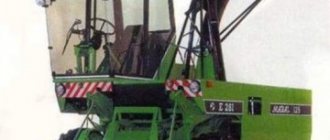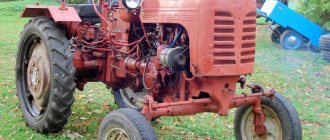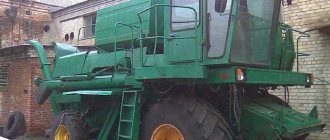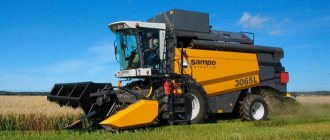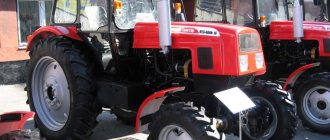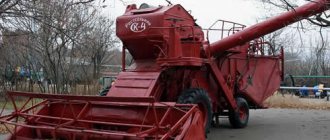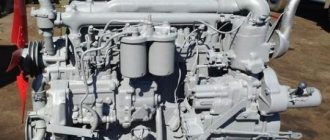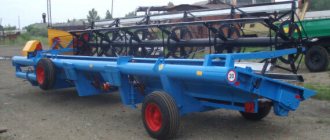A reaper is a device that cuts off the above-ground part of crop shoots and transfers them to the threshing apparatus. It can act as a separate unit or as an integral part of combined machines. The combine header is a separate automated working element. Designed for cutting and transporting collected material to the chopper drum or rotor. When combining separately, the cut parts are felled, i.e. are removed into windrows.
The device of headers for a combine harvester
The technological basis of most harvesters is cutting off shoots of agricultural crops. This design principle is considered classic, but there are other options. Today, harvesters have appeared that are capable of threshing seeds without the cutting operation - directly on the root while preserving the vegetative mass of the crop. Such headers are called stripper headers.
The main mechanisms of the headers are:
- reel – advances the shoots to the knives and holds them until the end of this process;
- cutting block blades - work on the principle of scissors, since they consist of movable and fixed elements;
- auger – occupies the central part of the header and delivers the mown spikelets to the entrance to the inclined chamber;
- inclined conveyor (or inclined chamber) - its rotating shafts receive the ears of corn and move them into the drum.
Additional details include:
- devices that help copy topographic irregularities - for example, on John Deere combines - these are hydrocopiers that help avoid collisions of the working parts of the equipment with stones, earthen deposits, etc.;
- suspension units for balancing the overall structure - prevent the header from skewing in a transverse or longitudinal position;
- side dividers - separate the area for bevel from the total grain mass.
Purpose and device
The header of the Niva SK 5 combine or other unit consists of several parts.
- Executive agency. Using knife parts, he cuts off the stems. It is assembled from knives, timber, clamps, and a drive mechanism. The dividers carry the crops to the knives, where the cutting occurs.
- Reel. Bends the stems to the executive body. The paddle device processes upright plants. Lifting drums mow down tangled stems of agricultural crops.
- Transport tape. It delivers the cut plants to the ejection window or the receiving window of the thresher.
- Control mechanism. It is needed to adjust the header of a combine harvester, correct installation of the thresher, and cutting height.
Types of harvester headers
Harvesters for agricultural machinery can be classified according to several criteria. Among them:
- cleaning method;
- localization of the cutting part blades;
- features of use;
- principle of autonomy.
According to the first criterion, the headers are:
- screw - for direct combining. In one phase, most mature crops are harvested, as well as low-growing crops and sparse grains, the density of which is up to 300 individuals. stems/1 m2;
- platform – for two-phase combining. They allow you to perform only a few tasks - mowing crops and swathing them. Their design is somewhat different from auger headers. There is also a reel and knives here. Only after cutting and crushing, the harvested crop does not enter the feeder chamber and beater drum, but onto a platform, from which it is transported through the unloading compartment to the windrow stacker.
Depending on the layout of the stem cutters, the following types of headers are distinguished:
- frontal;
- lateral.
Due to the specific application:
- universal – used for a wide range of crops;
- specialized - for a specific agricultural crop.
In terms of autonomy:
- mounted headers - are mounted adapters that are attached to a tractor or combine;
- trailed – towed by self-propelled agricultural machinery;
- self-propelled – equipped with a traction mechanism and transport units.
Principle of operation
The equipment can be suspended or coupled to units. Some models work independently.
The machines have a similar principle by which they perform bevels.
- The longitudinal bars of the device capture and guide the stems to the cutting devices.
- Knives process agricultural crops.
- The processed silage ends up on the belt.
- The windrows are thrown onto the field or into the machine.
In one pass, the equipment makes a single windrow. Depending on the power of the tractor itself, the device can achieve high processing speed.
Header types:
- Mounted. Used for separate collection of agricultural crops. Cuts and forms sheaves or windrows from stems. The equipment is equipped with an ejection window and a reel with a rake.
- Trailed. Installed on tractors with the power to mow crops. Designed for those farms where the field width is small.
- Self-propelled. A functional model that cuts the stems and then picks them up. As a result, raw material losses are reduced and work productivity increases.
- Combing. The header of a combine harvester uses innovative methods for harvesting grain crops. It acts on the ears, leaving the stems intact. These minimize fuel consumption and equipment wear.
It is advisable to select equipment depending on the width of the field, landscape features, and type of unit. Farmers pay attention to the design features of the models. Then you can perform work with high efficiency and productivity.
Mounted headers
They are attachments for self-propelled wheeled or tracked chassis of mini-equipment or full-size combines, connected to them through a power take-off shaft (for example, ZhVN-6A, ZhSK-4A).
Externally it looks like a frame-type platform device. The supporting elements are shoes to follow the field topography, thanks to which the header will always be above the ground level.
Technical characteristics of ZhVN-6
Having studied the structure of the unit and the main elements of its design, it is advisable to find out its technical characteristics, which made the model one of the most popular solutions for harvesting. The ZhVN-6 header, which weighs 969 kg for the base model, appears to be a universal unit.
The weight of its improved B-version reaches 1065 kg, despite the same performance indicators, which is due to differences in design.
Among the key operating parameters of the product it is worth mentioning:
- working width - 6 m;
- speed when working/moving - 12/18 km/h;
- productivity - 4.8 ha/h;
- drive type - crank or MPN according to the Schumacher type;
- reel rotation speed - 24-64 revolutions per minute.
The reaper is used to collect grain crops
Thanks to its simple design and excellent technical parameters, the equipment has become widespread among large farms.
Trailed headers for combine harvesters
Connected to a tractor or minitractor by a hitch (for example, ZhVP-4.9). Structurally very similar to the previous type. Only instead of a hinged unit they have spherical hinges, and the shoes are replaced with transport wheels. Unlike other varieties, they are more maneuverable because they are towed by a vehicle with smaller dimensions.
Universal or special: choosing a sunflower header
Many farmers are familiar with the problem of choosing: to purchase special headers of various types or to harvest all crops with a universal header? Some people think that special headers will pay for themselves by reducing losses, while others don’t see the point in spending on a large amount of equipment. How to find a balance, why and under what conditions is it profitable to buy special equipment - questions that everyone solves in their own way.
The advantages of a universal header are clear: one implement for all types of crops in crop rotation, no need to spend money on several headers. However, losses when harvesting sunflowers with a universal header are significantly higher than when using specialized equipment.
Sunflowers are often harvested using a converted corn header . This method has the following disadvantages:
- Corn headers are equipped with mechanisms to cut the cobs from the stalk. These devices are not needed when harvesting sunflowers. Their operation leads to excessive fuel consumption.
- The corn header cuts off most of the stalk. Excess waste is clogged by the MSU (threshing and separating device).
- When working with a corn header on sunflowers, the speed of the combine is significantly lower than with a specialized header. At speeds above 4 km/h, the harvester's MSU simply will not keep up with the collection of baskets.
| When harvesting sunflower with a non-specialized harvester, losses can reach 30%. When switching to specialized equipment, farms increase seed collection by 5-7 centners per hectare. |
Lifters for sunflower harvesting
Many small farms use special attachments for grain headers, which allow them to harvest sunflowers. Such devices include various types of elevators for headers. Prototypes of such devices were constructed in the first half of the 20th century. After the designer of the first device, which was used by Soviet farms for quite a long time, such attachments are called Zmievsky devices.
Lifter device for harvesting sunflowers
As the name suggests, the lifter lifts the plants and guides them towards the cutting elements. To convert a grain header into a sunflower header, the reel should be dismantled and a solid shaft with grippers installed instead. Then a stand with guides is attached to the header, to which chutes-elevators are attached, and side dividers are installed.
Such devices are 4-5 times cheaper than specialized sunflower headers, but their loss percentage is much higher. A large number of seeds and even whole baskets are knocked off the shaft and fall to the ground.
| Even if we calculate the increase in sunflower yield when switching to a specialized harvester to be equal to 1 c/ha, at the average price of seeds, a sunflower harvester will pay for itself when harvesting an area of 500 hectares or more. |
Price
The price for this type of special equipment is determined by its modification, year of manufacture, and condition. Since the production of headers of this model has not yet been stopped, everyone has the opportunity to purchase both new and used products. When planning to buy new equipment, you should take into account that its cost is about 320 thousand rubles.
If you study the catalog of spare parts for this model, you can conclude that its maintenance will not require serious financial investments from the owner. The cost of a used header can vary and depends on many factors. Average prices are 70-130 thousand rubles.
Operation and Maintenance
The machine is operated in accordance with the instructions, and maintenance is carried out in accordance with the established regulations.
The corn cleaner must be in good condition during its service life. Operating the machine without maintenance is not allowed.
Before work, the header is prepared for assembly and work with the combine. To do this, it is installed on a flat area, attached and pulled in with tightening hooks. Then a run-in is carried out and the heating of the bearings and gearboxes and the tightening of fasteners are checked. The duration of the process is at least 1 hour.
When connecting for the first time, adjust the gap between the hook and the locking rod and adjust the angle of inclination of the cutting knife relative to the ground.
Modifications
Features of the operation of the ZhVN-6 header include periodic checking and lubrication of drive mechanisms, checking the condition of fasteners and the condition of the scythe segments.
In general, ZhVN-6 is a general designation for headers, since there are several modifications of them that differ in certain design features. So, the basic one is the ZhVN-6B header. It uses a certain type of drive, and the scythe is driven by a crank gearbox.
There are other headers, for example, ZhVN-6A, but the main differences between them come down to the type of drive and gearbox. Also, some of them have wider applicability on equipment. But the main characteristics of these headers are the same.

